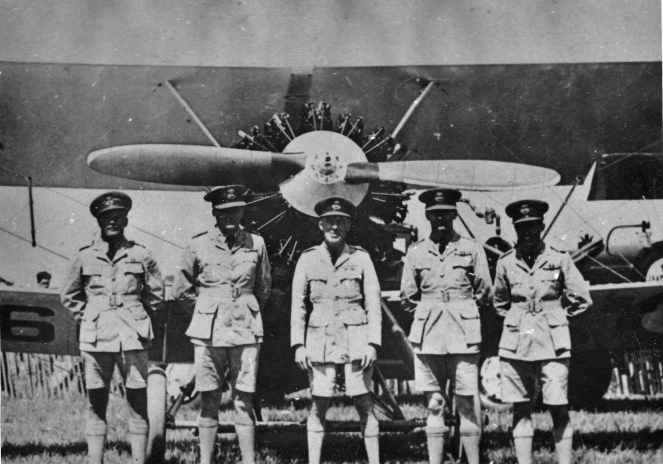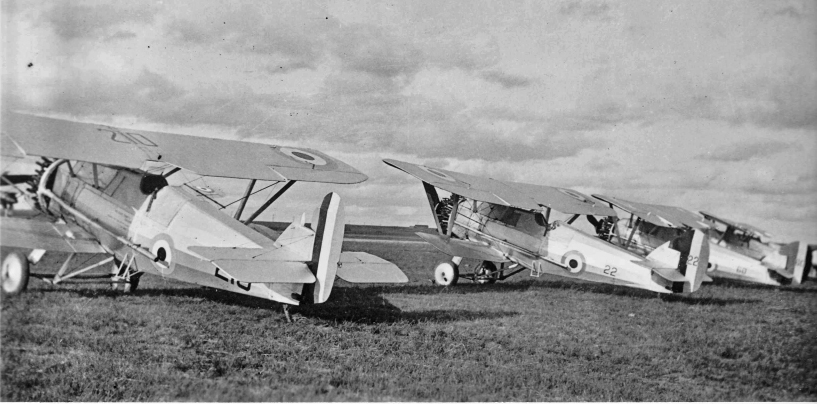 Museum
Museum  |
Bomber Command
|
Aircrew Chronicles
|
Aircrew Losses
|
Nose Art
|
BCATP
|
Lancaster
|
Media
|
Bomber Command
|
Aircrew Chronicles
|
Aircrew Losses
|
Nose Art
|
BCATP
|
Lancaster
|
Media
 Museum
Museum  |
Bomber Command
|
Aircrew Chronicles
|
Aircrew Losses
|
Nose Art
|
BCATP
|
Lancaster
|
Media
|
Bomber Command
|
Aircrew Chronicles
|
Aircrew Losses
|
Nose Art
|
BCATP
|
Lancaster
|
Media
Bomber Command Museum Chronicles
There is a bit of High River history not known by many of today's residents. It concerns an amusing, and perhaps dubious part, that High River played in the defense of Canada. Defense of Canada, you ask? How could this have happened out here in the boondocks?
Well, it concerned the High River Air Station, a crude collection of portable First World War Hangars made of wood frames and originally covered with canvas. These distinctive barn-like buildings, with curved roofs and sloping sidewalls were anchored to the ground with a bit of concrete on the prairie grass northeast of town in 1921. The purpose of this Dominion Government establishment was to create a base from which airborne forestry patrols could be carried out on the eastern slopes of the Rockies. Additional duties included RCAF development flying, the testing of airplane engines in cold weather, parachute jumping practice and the exploration of mountain passes for air routes.
|
For about ten summer seasons, from its initial setup in 1921 to 1931, airplanes of mostly First World War vintage carried out daily patrols looking for tell-tale smoke, and thus were able to alert ground forces of fire early. In 1931 an act of Parliament transferred the resources of this province, and the care of same to the provincial government. With the responsibility of forest protection taken from the Dominion government, then wrestling with the massive problems of the great depression, the Air Station was closed and left in the care of a watchman. Elsewhere in Canada, in the late twenties and early thirties, the RCAF carried out mostly non-military duties with the exception of that of the fighter aircraft which the RCAF possessed. These fighter aircraft, less than a dozen in number, were purchased in 1929 and to the taxpayer formed a very visible element of the RCAF. They formed an aerobatic display squadron. This thrilled Canadians from coast to coast, especially in 1931 -displaying formation aerobatics much as the Snowbirds of today. Because this aircraft, a fabric-covered biplane painted silver in colour and built by the Armstrong Whitworth Company in Britain, was called the 'Siskin', this aerobatic squadron was called 'The Siskins'. Just as happens nowadays, the penny-pinching government did not see a need to update their air force, and so into the mid-thirties the Siskins became obsolete, in fact more than obsolete, they probably became an embarrassment. By 1938, their existence near Ottawa in the centre of Canada was such an embarrassment that the Siskins were shipped out to a less obvious station in Calgary. The remnants of the squadron with about five remaining airplanes, were dutifully serviced and flown from the then, new airport at Lincoln Park (now the site of Mount Royal University). The commanding officer of the squadron, even then prominent for his pioneering efforts in aviation, was Squadron Leader Elmer Fullerton. |
  
|
ln late 1938, with a war imminent, the government finally purchased some new fighter airplanes able to fly 320 rnph, almost 200 mph faster than the poor old Siskins being replaced. The Siskins were flown down to the High River Air Station and put-in storage in one of the old hangars previously mentioned. Several months later, September 3, 1939, war was declared by Britain, and by Canada a week later. The High River Air Station, now housing what had been in the previous year Canada's front line fighter defense, was bolstered with some guards. The following story was related to me by Bill Smith, manager of the Calgary Flying Club, some thirty years ago. "I was instructed lo go down to High River to examine the facilities for use as a flying training base, and on landing there I found three militia guards, very agitated and nervous. I asked what was the matter? Well, it seemed that one older militia guard, who had apparently served in the First War, had been regaling the two younger guards with stories of the great conflict, and his part in it. The younger guards, perhaps somewhat bored and not unused to playing pranks, decided to spook the older guard, and created some noises in the back of one of the hangars by firing blanks from their service rifles. The older guard, not to be intimidated by 'foreign saboteurs' on the base, poked his service Lee Enfield rifle into the hangar and let off a volley of shots. He created a hell of a mess, bullets ricocheting off concrete, engines, and metal parts. There were smashed engine magnetos and numerous holes in the Siskins. A commercial airplane, Fairchild CF-AOP, stored there while on a contract of aerial mapping was also damaged. Next time I came to High River, the Siskins were gone." Records indicate that this incident happened September 6, 1939. It is not recorded what happened to the prank-playing guards. The Siskins were subsequently shipped out to serve in a technical training school and thousands of airplane mechanics learned their trades disassembling and assembling the myriads of tiny parts on these old airplanes. When they were too worn out even for that, they were sold by war assets or melted down in war-scrap drives. |
What is this legacy of High River in the defense of Canada you ask? Well, High River may have been the site of the first shots fired in anger by a Canadian in the Second World War. It was certainly the first time that these airplanes, Canada's front line fighter defence for nine years, were ever fired upon in anger.
The site of this 'great conflict' is today an open field of prairie grass. Only some remnants of the hangar foundations are still visible in the ground between the roadway and the red wartime hangar which now houses a manufacturing plant. A mural of one of the Siskins is featured on the wall of the Telus Building in High River. The mural is technically accurate, except the colour of the Siskin should be silver, not yellow. It should be performing aerobatics in front of a crowd, not fire spotting as the painting shows.

